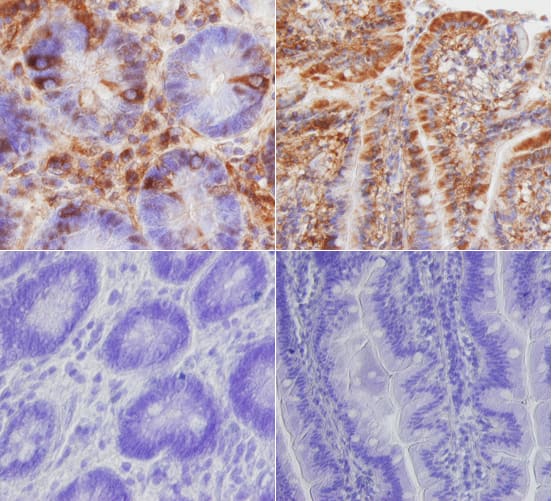Mouse CCR3 Antibody Summary
Met1-Phe359
Accession # P51678
Customers also Viewed
Applications
Please Note: Optimal dilutions should be determined by each laboratory for each application. General Protocols are available in the Technical Information section on our website.
Preparation and Storage
- 12 months from date of receipt, -20 to -70 °C as supplied.
- 1 month, 2 to 8 °C under sterile conditions after reconstitution.
- 6 months, -20 to -70 °C under sterile conditions after reconstitution.
Background: CCR3
CCR3 is a G protein-linked seven transmembrane receptor that is activated by several different chemokines. It is expressed on subsets of granulocytes, monocytes, T cells and epithelial cells.
Product Datasheets
Citations for Mouse CCR3 Antibody
R&D Systems personnel manually curate a database that contains references using R&D Systems products. The data collected includes not only links to publications in PubMed, but also provides information about sample types, species, and experimental conditions.
9
Citations: Showing 1 - 9
Filter your results:
Filter by:
-
Effects of a herbal formulation, KGC3P, and its individual component, nepetin, on coal fly dust-induced airway inflammation
Authors: E Saba, YS Lee, WK Yang, YY Lee, M Kim, SM Woo, K Kim, YS Kwon, TH Kim, D Kwak, YC Park, HJ Shin, CK Han, JW Oh, YC Lee, HS Kang, MH Rhee, SH Kim
Sci Rep, 2020-08-20;10(1):14036.
Species: Mouse
Sample Types: Whole Cells
Applications: Flow Cytometry -
CCL28 promotes locomotor recovery after spinal cord injury via recruiting regulatory T cells
Authors: P Wang, X Qi, G Xu, J Liu, J Guo, X Li, X Ma, H Sun
Aging (Albany NY), 2019-09-26;11(18):7402-7415.
Species: Mouse
Sample Types: In Vivo
Applications: Neutralization -
Breast milk immune complexes are potent inducers of oral tolerance in neonates and prevent asthma development.
Authors: Mosconi E, Rekima A, Seitz-Polski B
Mucosal Immunol, 2010-05-19;3(5):461-74.
Species: Mouse
Sample Types: Whole Cells
Applications: Flow Cytometry -
CCR1 expression and signal transduction by murine BMMC results in secretion of TNF-alpha, TGFbeta-1 and IL-6.
Authors: Fifadara NH, Aye CC, Raghuwanshi SK, Richardson RM, Ono SJ
Int. Immunol., 2009-07-10;21(8):991-1001.
Species: Mouse
Sample Types: Whole Cells
Applications: Flow Cytometry -
CCR3 is a target for age-related macular degeneration diagnosis and therapy.
Authors: Takeda A, Baffi JZ, Kleinman ME, Cho WG, Nozaki M, Yamada K, Kaneko H, Albuquerque RJ, Dridi S, Saito K, Raisler BJ, Budd SJ, Geisen P, Munitz A, Ambati BK, Green MG, Ishibashi T, Wright JD, Humbles AA, Gerard CJ, Ogura Y, Pan Y, Smith JR, Grisanti S, Hartnett ME, Rothenberg ME, Ambati J
Nature, 2009-06-14;460(7252):225-30.
Species: Mouse
Sample Types: In Vivo, Vitreous Humor
Applications: Neutralization -
Ablation of type I hypersensitivity in experimental allergic conjunctivitis by eotaxin-1/CCR3 blockade.
Authors: Miyazaki D, Nakamura T, Ohbayashi M, Kuo CH, Komatsu N, Yakura K, Tominaga T, Inoue Y, Higashi H, Murata M, Takeda S, Fukushima A, Liu FT, Rothenberg ME, Ono SJ
Int. Immunol., 2009-01-15;21(2):187-201.
Species: Mouse
Sample Types: In Vivo, Whole Tissue
Applications: IHC-Fr, Neutralization -
CD11b+ myeloid cells are the key mediators of Th2 cell homing into the airway in allergic inflammation.
Authors: Medoff BD, Seung E, Hong S, Thomas SY, Sandall BP, Duffield JS, Kuperman DA, Erle DJ, Luster AD
J. Immunol., 2009-01-01;182(1):623-35.
Species: Mouse
Sample Types: Whole Cells
Applications: Flow Cytometry -
Siglec-F antibody administration to mice selectively reduces blood and tissue eosinophils.
Authors: Zimmermann N, McBride ML, Yamada Y, Hudson SA, Jones C, Cromie KD, Crocker PR, Rothenberg ME, Bochner BS
Allergy, 2008-09-01;63(9):1156-63.
Species: Mouse
Sample Types: In Vivo, Whole Cells
Applications: Flow Cytometry, Neutralization -
Toll-like receptor-2-mediated C-C chemokine receptor 3 and eotaxin-driven eosinophil influx induced by Mycobacterium bovis BCG pleurisy.
Authors: D'Avila H, Almeida PE, Roque NR, Castro-Faria-Neto HC, Bozza PT
Infect. Immun., 2006-12-11;75(3):1507-11.
Species: Mouse
Sample Types: In Vivo
Applications: Neutralization
FAQs
No product specific FAQs exist for this product, however you may
View all Antibody FAQsIsotype Controls
Reconstitution Buffers
Secondary Antibodies
Reviews for Mouse CCR3 Antibody
Average Rating: 5 (Based on 1 Review)
Have you used Mouse CCR3 Antibody?
Submit a review and receive an Amazon gift card.
$25/€18/£15/$25CAN/¥75 Yuan/¥2500 Yen for a review with an image
$10/€7/£6/$10 CAD/¥70 Yuan/¥1110 Yen for a review without an image
Filter by:



















